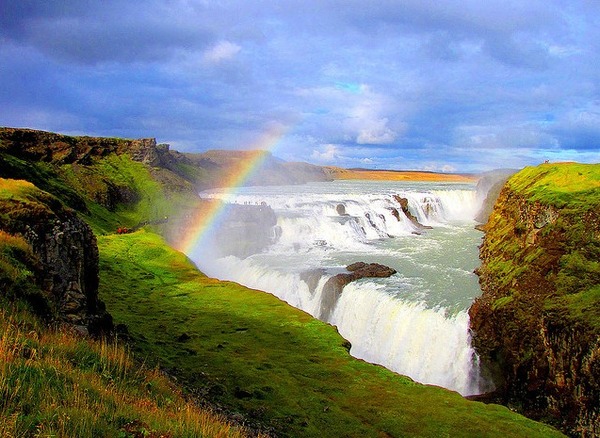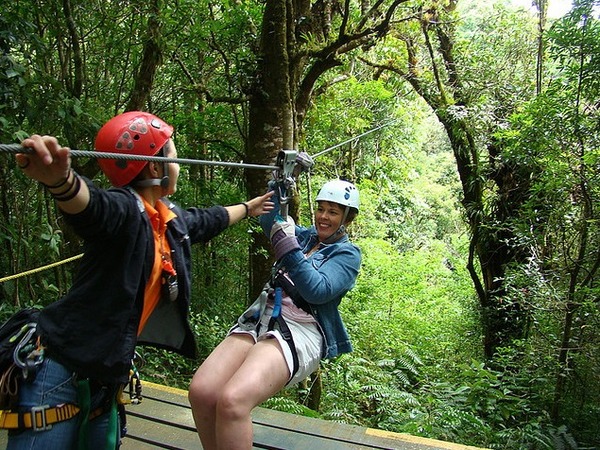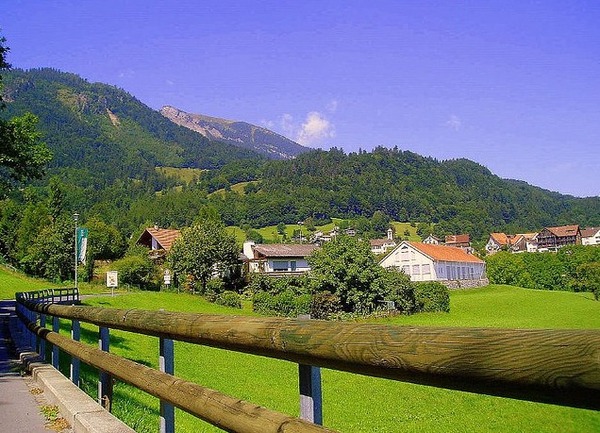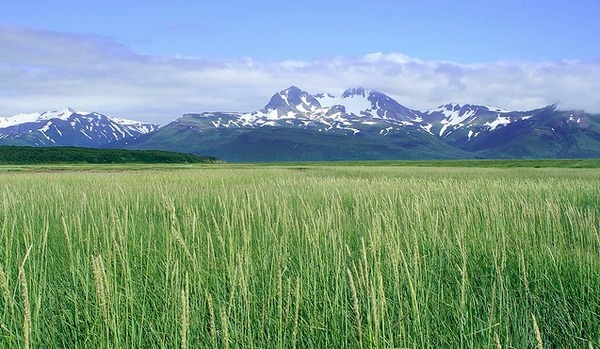Beautifully Green Travel: 12 Ecotourism Destinations

Ecotourism has become a hot buzzword when it comes to travel. Defined by the International Ecotourism Society as “responsible travel to natural areas that conserves the environment and improves the well-being of local people,” it’s part of the wave of green initiatives sprouting up all over the world. Ecotourism also tends to focus on getting out of the hotel and into the natural world, away from the beaten path and into areas that sometimes get missed, to learn about native cultures and ecology and help preserve the natural beauty and wonders of the planet.
From exotic, far-flung locales like Belize and Iceland to surprisingly green destinations closer to home, we’ve tracked down 12 of the best green travel spots in the world. Start planning your next trip… or just be an armchair tourist!
Belize

Located on the northeastern coast of Central America, Belize has become a popular ecotourism destination. With thick forests and a gorgeous tropical coastline, the country packs more than 87 distinct types of ecosystems into less than 9,000 square miles, an area about the size of New Jersey.
Tourism in general and ecotourism specifically are among the most important industries in Belize, and it’s no surprise. With a spectacular barrier reef (and the world-famous Blue Hole), over a thousand cays (islands), abundant wildlife, and excellent waters for fishing, snorkeling, scuba diving, and kayaking, there’s no end to the adventures waiting to be had.
Iceland

On the other side of the spectrum from tropical Belize, Iceland offers a surprising array of ecotourism options. This land of fire and ice is known for its volcanoes, fjords, hot springs, and a nationwide commitment to sustainable and environmentally conscious living. Virtually all of Iceland’s electricity comes from renewable resources, including geothermal, wind, and hydroelectric power, and the Icelandic Tourism Board rewards hostels, hotels, tours, and attractions for green practices.
While you might think of Iceland as a cold and inhospitable environment, quite the opposite is true! The choice is yours, whether you want to spend your vacation relaxing at a geothermal spa, enjoying a whale watching boat tour, or horseback riding in the mountains. You’ll certainly not lack for fun things to do on this northern island. We can’t promise that Eyjafjallajökull won’t spout more travel-disrupting plumes of ash, as it did in 2010, but at least you’d get to witness some striking visuals!
Dry Tortugas
Located about 70 miles west of Key West, Florida, the Dry Tortugas islands and the waters around them make up Dry Tortugas National Park, a location only accessible by boat or seaplane. You won’t find a single car on any of these islands, and you won’t find any naturally occurring fresh water, either, which is where the islands’ name comes from.
The islands are famous for sea life, coral reefs, shipwrecks, and the unfinished Fort Jefferson, the largest masonry structure in the Western Hemisphere. Popular activities include birdwatching, scuba diving, picnicking, camping, and saltwater fishing. Just don’t forget to bring plenty of water, but you’re on your own if the rum is gone, too.
Burlington, Vermont
This small New England city, located on the shores of Lake Champlain, is proud of its eco-friendly culture. More than a third of Burlington’s energy comes from renewable resources. Pesticides aren’t allowed on public parks, land, or waterways, and residents have formed an extensive network of citizen-based environmental initiatives. Even the school systems use locally and organically grown food in their cafeterias.
With cold, snowy winters, warm summers, and gorgeous fall foliage, Burlington offers a wide range of activities to suit every interest. Local events include the Festival of Fools (yes, that’s “fools,” not “foods”), the Vermont Brewers Festival, and the Giant Pumpkin Regatta and Festival; Burlington is also home to one of the largest year-round farmers’ markets in the state.
Costa Rica

With 20 national parks, it’s not surprising that the Central American nation of Costa Rica has a thriving ecotourism industry. It was also cited by the United Nations Development Programme for attaining high human development and equality as well as environmental sustainability, ranking fifth in the world and first in the Americas in the 2012 Environmental Performance Index.
One of the greenest countries in the world, Costa Rica was a pioneer of ecotourism and offers a huge range of tours, volunteer opportunities, and activities.
San Francisco, California
Long a bastion of counterculture icons and progressive thinkers, San Francisco is considered to be the second greenest city in America (after Portland, Oregon). You don’t need a car to get around most parts of the city, with most tourists and residents alike opting to bike, walk, or take public transportation to get where they’re going.
The city also maintains more than 200 parks, from the iconic Golden Gate Park to the Japanese Tea Garden. You’ll find many excellent environmentally-conscious hotels and businesses in the area.
Switzerland
Switzerland might be best known for its skiing and alpine views, but this European country is also one of the world’s most environmentally-conscious. Hydroelectric and nuclear power provide most of the country’s electricity, and a far-reaching rail network makes it easy to get around without needing a car.
A little bigger than Maryland, Switzerland is home to biodiversity of both landscapes and climates. From alpine glaciers to lakes, forests, pastures, and the headwaters of several famous rivers that flow across Europe, there’s definitely something for everyone.
Portland, Oregon
The citizens of Portland like to say that their city, regularly named one of the greenest cities in the world, was green before green was cool. Public transportation, bicycles, and walking are the most popular modes of transportation within the city limits. Green-certified buildings and businesses are on every street corner, and numerous parks dot the landscape.
Forest Park is the largest wilderness park within any city’s limits in the United States; you’ll also find a world-famous zoo, Japanese Garden, and the International Rose Test Garden. With more than 40 breweries calling Portland home, it’s also been named the best city in the United States for happy hour!
Jackson Hole, Wyoming
Jackson Hole is actually the name of a valley near the border of Idaho in the Teton Mountains. The town of Jackson is its only incorporated town, and the valley is a mecca for tourists exploring Grand Teton and Yellowstone National Parks, Jackson Hole Mountain Resort, and the Snow King and Grand Targhee Resort ski areas.
Jackson is alsohome to the National Museum of Wildlife Art, the Grand Teton Music Festival, and the Center for the Arts, as well as a thriving downtown shopping and entertainment district and a wide variety of sporting activities, from dogsledding to parkour. Many local businesses strive to follow eco-friendly guidelines and green practices, since much of the region’s economy is based on preserving its natural beauty.
Alaska
America’s largest state is an outdoor lover’s paradise. This state of sweeping vistas, vast wilderness, and spectacular scenery is a prime destination for travelers seeking a connection with nature at its wildest.
The Alaska Wilderness Recreation and Tourism Association represents more than 300 nature-based tourism businesses, individuals, and organizations offering natural history tours, rafting, fishing, kayaking, hiking, backpacking, wilderness lodges, hunting, and day ocean cruises and charters trips. The association also advocates for sustainability of the state’s natural and cultural resources.
New Zealand
New Zealand is located in the Pacific Ocean, across the Tasman Sea from Australia. It’s a remote nation comprised of two large islands and numerous smaller islands, a place of distinctive biodiversity that includes a number of species unique to the island. With a geography ranging from steep, snow-covered mountains to tropical beaches, New Zealand’s range of available activities is incredible. Given the country’s distance from the rest of the world, it’s not surprising that sustainability and eco-friendly practices are widespread. Some 31% of New Zealand’s energy supply comes from renewable sources, primarily hydroelectric and geothermal power.
Ecotourism is a thriving industry in the country, with wildlife tours showcasing everything from whales to parrots and activities from kayaking to mountain biking. Many resorts and tour companies cater to the green traveler, with organic, locally sourced, and environmentally conscious accommodations and activities.
Volunteer vacations
Looking for a truly rewarding travel experience? Try a volunteer vacation. Driven by people’s desire to do something to give back to the world, volunteer tourism has grown significantly in recent years, offering experiences ranging from weekend trail repair trips in National Parks to journeys to assist with environmental research in Kenya.
There are hundreds of service organizations that conduct volunteer vacations; check the company’s background and credentials before signing up. Well-known organizations like the Sierra Club and Habitat for Humanity provide excellent options, though many lesser-known opportunities exist as well.
Volunteer trip accommodations range from well-appointed hotels to tents in the woods, so make sure you know what you’re signing up for. If you’re willing to work up a sweat or spend some time helping deserving organizations, a volunteer vacation could be just what the doctor ordered!
This story originally appeared on Tecca.com.








